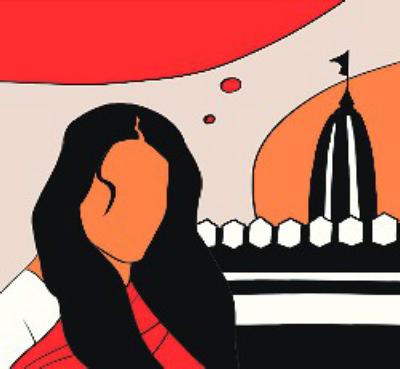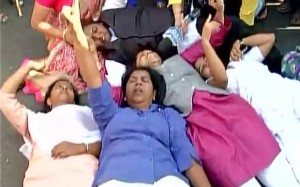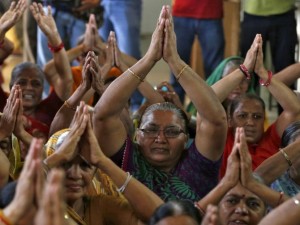In this blog post, Disha Pareek, a student of Rajiv Gandhi National University of Law, Punjab, writes about the extremely discriminatory, regressive and draconian traditions in India that prohibit women from entering the premises of certain temples. She also discusses how the Indian Judiciary has taken steps towards the abolition of such traditions and the reinforcement of women’s rights.
“Every rapist, murderer, thief or delinquent is allowed to enter a temple, but a menstruating woman cannot, this is the only crime she has committed.”
The demand for entering the sanctum of the temple is not new. Decades ago, the Dalits were barred from entering the temple because of untouchability. And for 400 years now, women are disallowed from entering the sanctum of various places of worship in India. But the recent Supreme Court and High Court of Bombay’s judgments have changed the scenario.
History of social reform
Dalits had been discriminated against for decades, and the demand for independence from the British and the clutches of discrimination against Dalits ran parallel. But later, they gained equal rights with those of other communities.
But we are in the 21st century and relying on age-old traditions, which are many a times, unreasonable, and placing them above showcases puts India as a very backward and regressive country on the world plane. For centuries, many places of worship, including temples and shrines have used the tool of tradition to keep women out of these places of worship. But it should be kept in mind that these bans are not compatible with the laws of India and even the Constitution of India.
Reasons for such practice
- The patriarchal set up in India has enforced such traditions and customs which are inherently opposed to women’s rights.
- The women themselves, due to illiteracy and lack of exposure, are unaware of their Constitutional and legal rights.
- The social reformers, who stand up for such a cause, are either killed or are coerced to shut their mouth (rationalist Narendra Dabholkar).
- The politicians lack the will to adopt any such measures due to vote bank politics.
- Traditions are in a greater hierarchical position than legislations, the rudimentary social values, which have now become archaic, are still in fashion. It is believed that if women enter into the altar or the sanctum sanctorum of the temple, it will be in contravention to the celibacy of God.
- The concept of purity also comes into play; the physical attribute of the women is linked to the purity of an idol and a temple even today.
Controversy in Indian places of worship
The background of the controversy dates back to the year 2000. Narendra Dabholkar, a popular rationalist protested so that women as a matter of right can worship on the ‘prohibited platform.’
The popular Shani Shignapur Temple in Maharashtra which made it into headlines for more than a month has prohibited women from entering the sanctum sanctorum of the temple. Sanctum is the holy place where the idol is placed. Different social reformists have now and then criticized this practice. But this became controversial in January 2016 when a woman mistakenly entered the sanctum and afterwards, in order to purify the idol of God, it was bathed in milk. This act degraded women and after this, Trupti Desai (a social activist) with her organization ‘Bhumata Brigade’ lead 1000 women activists and entered the temple forcefully as a gesture against the prevailing gender biased rules.
Until the year 2011, the level of discrimination was such that the women were not even allowed to enter the temple’s premises as well. The sad truth is that when these women activists were marching towards the temple, around 4000 people (including women) stopped them; the women in the Shignapur believe that if they enter the altar, a disaster will follow. In Maharashtra, the Maharashtra Temple Entry Act, 1956 has banned women from entering the premises of temples as the Act did for Dalits.
Bombay High Court verdict, 2016
As a victory for women rights activists, Bombay High Court paved the way for women’s entry into Shani temple and said that no law could prevent women from entering the temple, and there should be same law for everybody irrespective of any consideration.
This particular judgment had far-reaching implications as this judgment was reiterated on various occasions. The petitioners contended that the prohibition is arbitrary, unreasonable and illegal. The court also referred to the Maharashtra Hindu Place of Worship (Entry Authorisation) Act, 1956, Section 3 of which clearly states that no person could be prohibited from entering any temple by any person, and no custom or usage shall be considered superior to the provisions of the Act, and whosoever acts in the contravention of Section 3 shall be imprisoned for a term of 6 months or a fine of Rs 500.[1]The court had also opined that the government should give proper publicity to the Act and issue circulars, informing the general public at large about the Act and its provisions.
Sabarimala Temple controversy
The temple is located near the Western Ghats ranges in Kerala; this prominent temple is under the scanner of Supreme Court as a petition challenging the present custom of disallowing women from entering the temple is in motion. Here also, the practice is solely based on age-old traditions and no reasoning has been given.
Ruling by the Supreme Court
In Indian Young Lawyers Association v. Union of India[2] the Apex Court, while taking cue from the Bombay High Court decision on Shani Shignapur temple, held that no law or custom could justify the ban on entry of a woman to the temple. The court also criticized the 1991 Kerala High Court judgment S Mahendran v. the Secretary, Travancore Devaswom Board, Thiruvananthapuram[3]in which the High Court of Kerala upheld Section 3(b) of Kerala Hindu Places of Public Worship (Authorisation of entry) Rules which prohibits entry of woman and justifies the same.
National law
The Constitution of India, which is considered as the holiest legal document contains provisions which demand equality and non-discrimination.
- Equality before law: Article 14 of the Constitution of India states that there is a right to equality to every citizen of India, although reasonable classification is permissible. Relying on an age-old tradition dating back to 400 years ago cannot be permissible as it is unreasonable and arbitrary. Therefore, the women under the provisions of this article can claim equal rights with that of men.
- Articles 25, 26 and scope for state intervention: Where Clause 1 of Article 25 gives the right to all persons to profess, propagate and practice their religion and on the other hand Article 26(b) grants the right of managing the own affairs of religious denominations in the matter of religion. Article 25 (2) while overriding both of the above provisions allows state’s intervention in any religious practice for reasons of social welfare or to throw open any institute for all the sections of the citizen, thus allowing women to enter places to worship can be done by the state as well.
International law
International law is based on the pillars of equality and non-discrimination. India being a signatory to many international documents, one of which is Universal Declaration of Human Rights (UDHR)[4] mandates that every individual has freedom of religion without any discrimination.
Another international covenant, International Convention of Civil and Political Right (ICCPR) says that there is freedom of religion to one and all, but this is not absolute and can be restricted to protect public safety, health, order or any similar consideration. These limitations in no way are concerned with women’s entry into places of worship.
Conclusion
While some of the customs that have been followed from time immemorial cannot and should not be scrapped because they, many a times, attach a sense of morality and faith and by which a person’s conduct can be controlled, but the patriarchy that has sustained for such a long time and is still in place degrades a woman in such a way that it takes years for the whole community to rise again to Phoenix.
The Judiciary has a pivotal role to play; it is more or less an independent institution and unlike the government, it has nothing to do with vote bank. Also, the women should be aware of all their rights and traditions should no longer create a sense of terrorism among people.
Footnotes:
[1] Section 3&4, Maharashtra Hindu Place of Worship (Entry Authorisation) Act, 1956
[2] Writ Petition (Civil) 373 of 2006
[3] AIR 1993 Ker 42
[4] Article 18, Universal Declaration of Human Rights, available at http://www.un.org/en/universal-declaration-human-rights/
 Serato DJ Crack 2025Serato DJ PRO Crack
Serato DJ Crack 2025Serato DJ PRO Crack












 Allow notifications
Allow notifications




Unfortunately flawed logic, The article itself is way discriminatory.
Please note that even a Non-menstruating Female murderer, Non-menstruating Female thief or delinquent is ALSO allowed to enter a temple, but only a menstruating woman cannot, so don’t try to show a big picture when you don’t even know how to draw one.
Keep your channel V generation knowledge to yourself